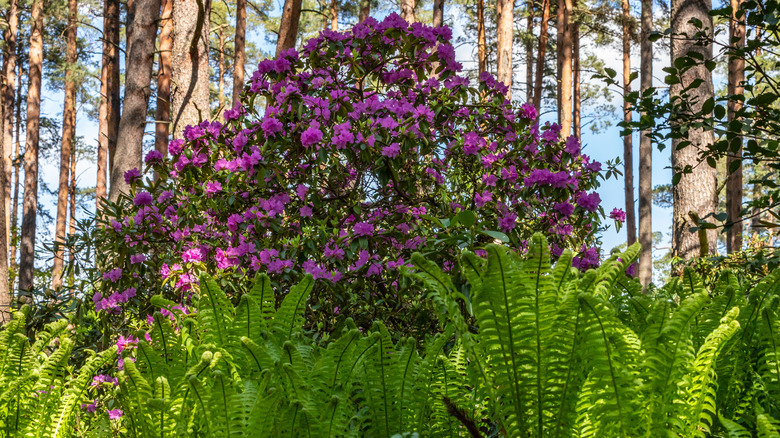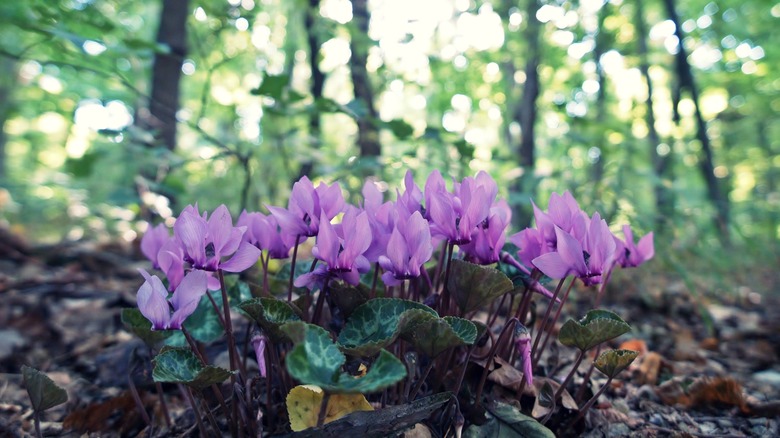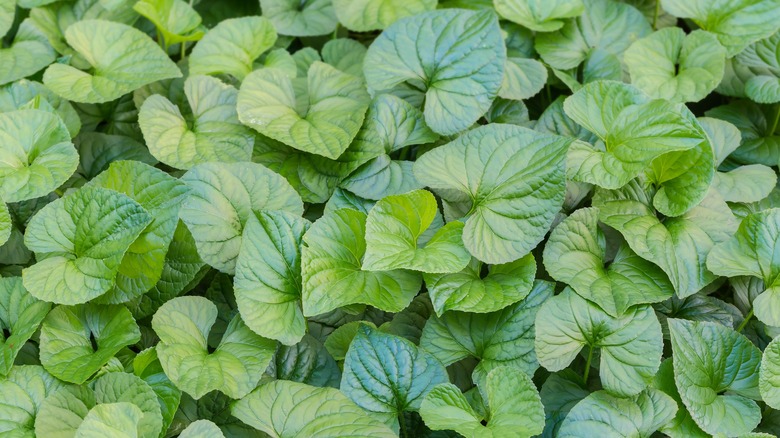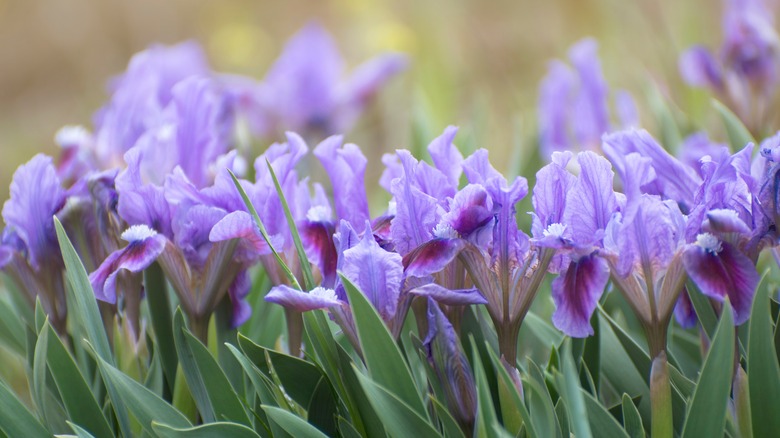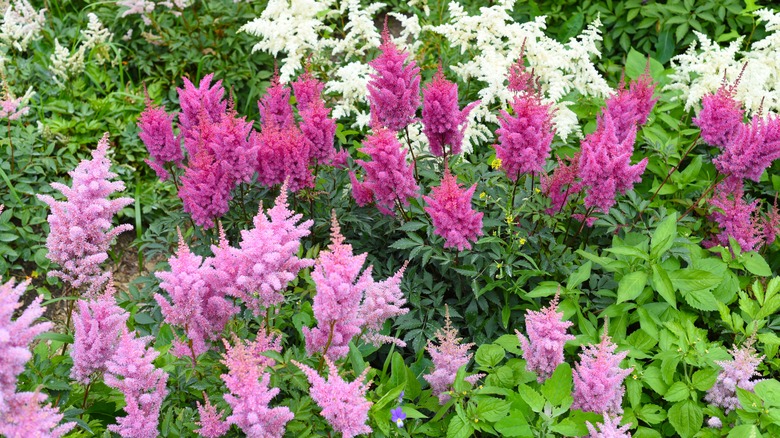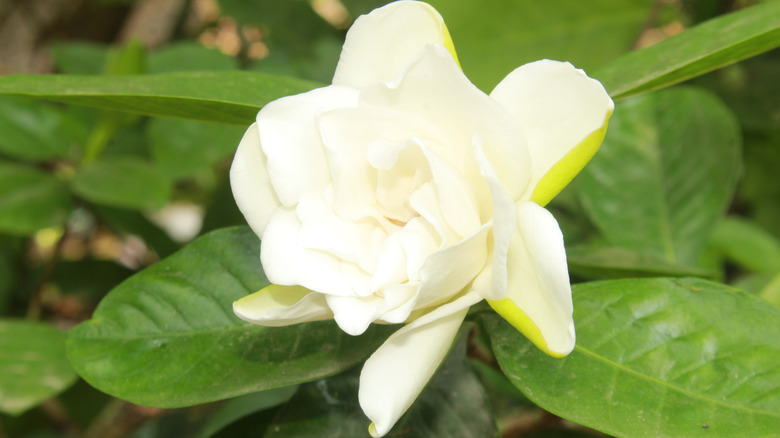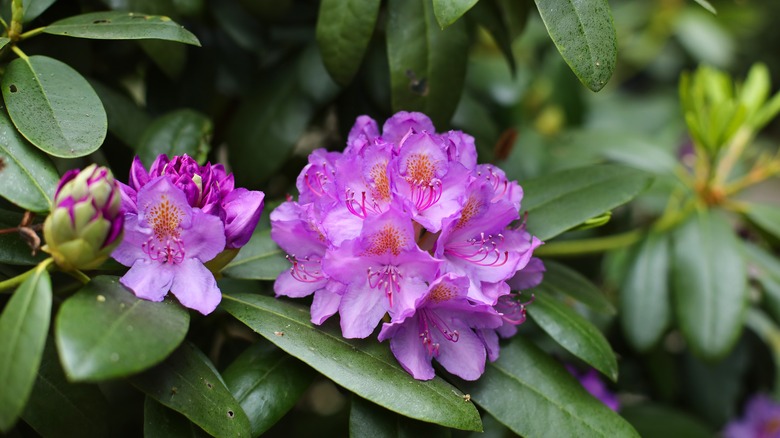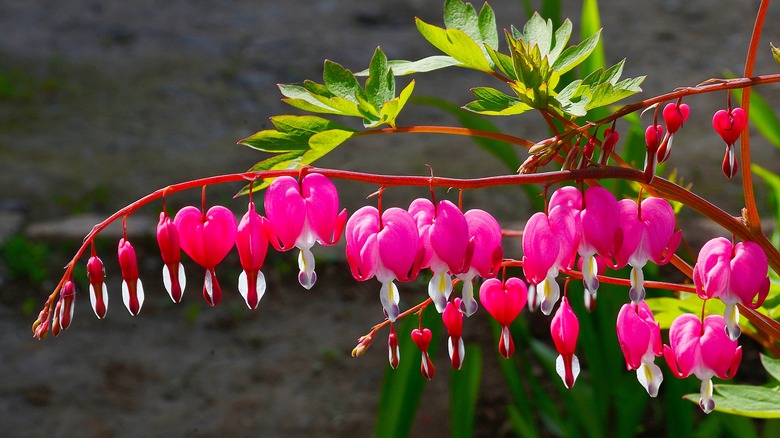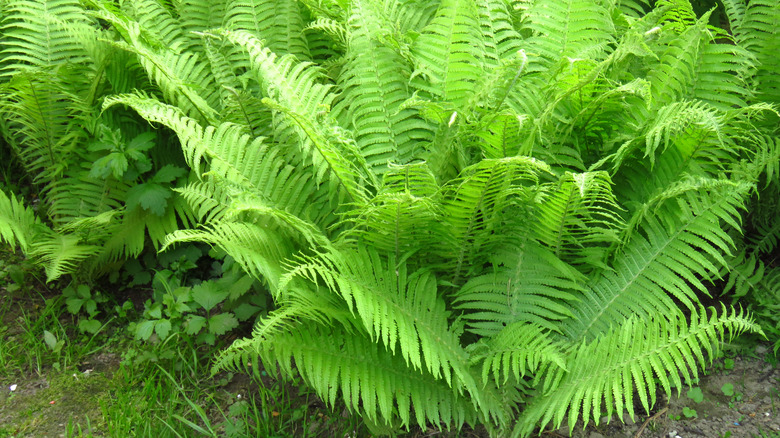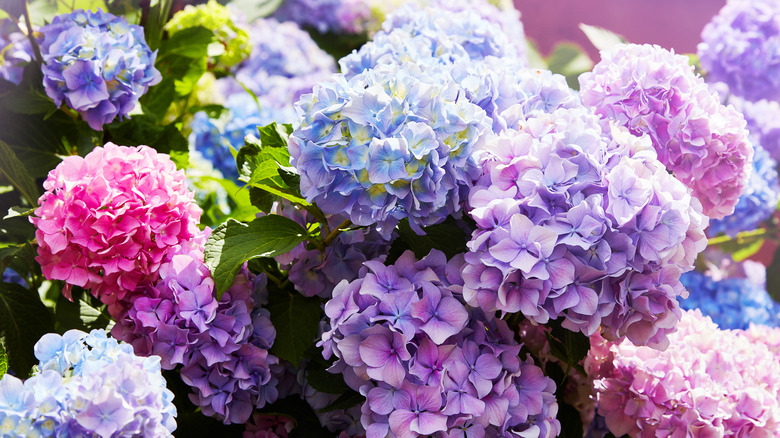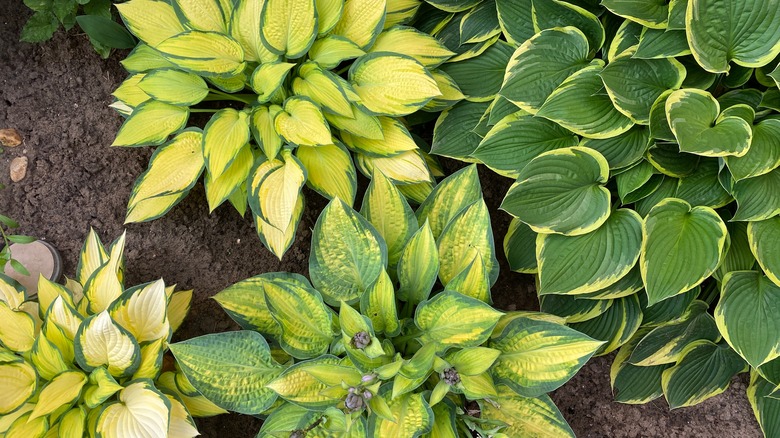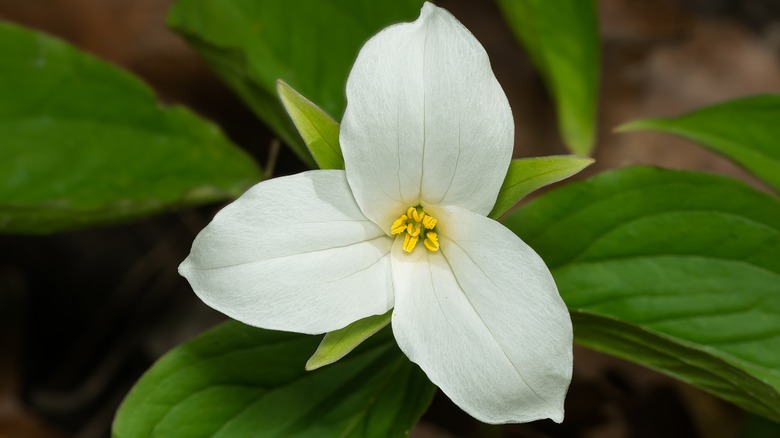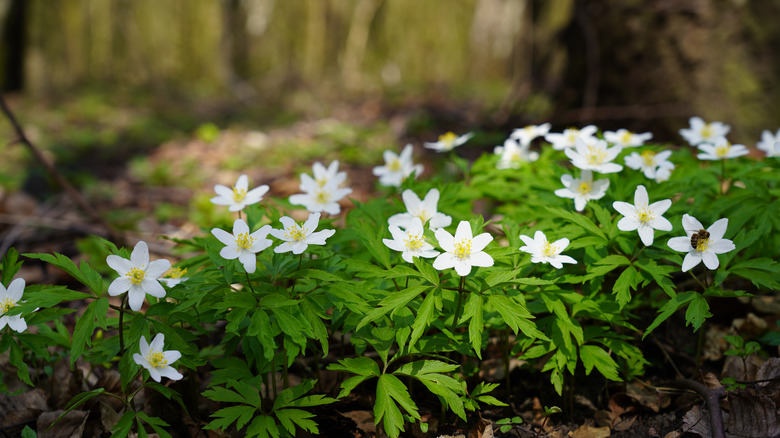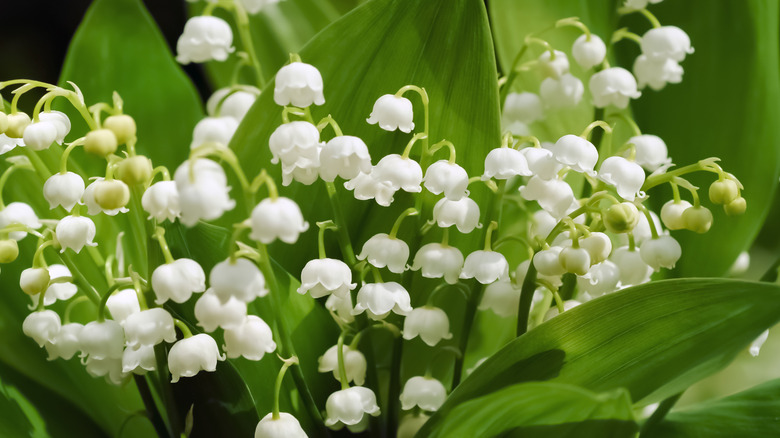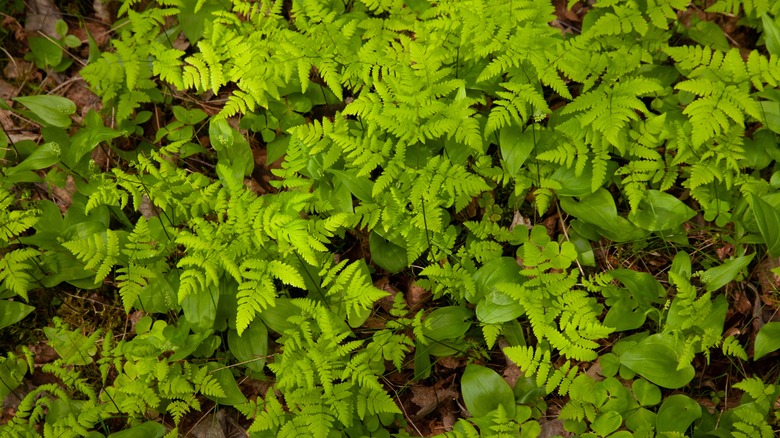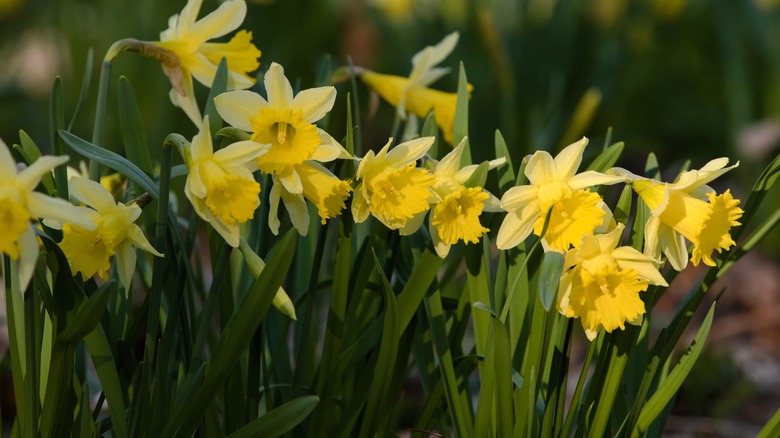15 Plants That Will Thrive Under A Pine Tree
If you have a pine tree in your yard, you're likely familiar with the struggle of getting plants to grow beneath it. With a thick canopy of needles and competitive roots with which to contend, not many species can survive the cool and shady conditions that exist beneath the trees. Because of these factors, many of our favorite flowers and foliage-filled plants that depend on direct sunlight and rich soil to thrive end up being choke out instead. Still, it is possible to brighten up the area with some specific species that do well in these conditions. Famously easy-to-grow choices such as bleeding hearts, lady ferns, and daffodils are the right plants for the job.
According to the University of Minnesota Extension, towering pine trees in your yard do not mean a death sentence for your dream garden. In fact, they can provide essential features to your natural landscape that help shield smaller plants from wind, heavy snowfall, and harsh sunlight. In addition to these benefits, pine trees also provide shelter for the insects and wildlife that pollinate flowers or eat the harmful aphids and mites feasting on your foliage. Don't let your tall trees make your landscape dark and lifeless, instead, check out our collection of plants that love the shaded environment pine trees provide.
1. Persian violet
Persian violets (Cyclamen coum) are hardy perennial flowers that usually grow less than 12 inches tall and spread just about as wide. This plant grows well under tall shrubs and trees, notes North Carolina State Extension. These violets need filtered sunlight or partial shade where they'll enjoy slightly acidic soil and low moisture.
Bloom Season: Fall to spring
USDA Growing Zone: 4 to 11
Growing Conditions: dappled sunlight to partial shade
Soil Type: Well-draining loamy sand
Size: 4 to 12 inches tall and 8 to 12 inches wide
2. Wild ginger
Wild ginger (Asarum canadense), an herbaceous perennial in the Aristolochiaceae or birthwort family, is native to parts of the U.S. and Canada. Typically grown as a ground cover in shady areas due to its short stature and growth requirements, Cornell Botanic Gardens says that you can plant wild ginger in a range of soil types as long as you water it regularly.
Bloom Season: Spring
USDA Growing Zone: 4 to 6
Growing Conditions: Partial to full shade
Soil Type: Evenly moist and well-draining
Size: 4 to 6 inches tall
3. Dwarf iris
The dwarf iris (Iris pumila) is known as a short plant with large flowers that can be purple, blue, or white with either white or yellow centers. Romence Gardens & Greenhouses suggests planting this summer blooming perennial in a cottage garden, rock garden, or container, however when planted below a pine tree, this low-growing flower adds a wave of color to the otherwise dark soil.
Bloom Season: Spring and summer
USDA Growing Zone: 4 to 8
Growing Conditions: Sun to partial shade
Soil Type: Well-draining
Size: 14 inches tall and 6 to 8 inches wide
4. False goat's beard
False goat's beard (Astilbe spp.) is a popular species of shade-loving plants that require very little attention. The flower is characterized by plume-like blossoms that may be cream, pink, red, white, or lavender. The foliage of the plant is also quite attractive with deep green leaves that are glossy and toothed, explains Longfield Gardens.
Bloom Season: Summer
USDA Growing Zone: 3 to 8
Growing Conditions: Partial shade
Soil Type: Evenly moist and well-draining
Size: 10 inches to 4 feet tall
5. Miniature gardenia
Gardenia flowers (Gardenia jasminoides 'Radicans'), also known as creeping cape jasmine, are loved for their scented white flowers that grow on branches commonly reaching heights of 6 to 12 inches tall, as noted by Monrovia. This small shrub, which has a nice spreading habit, does not require full sun or too frequent watering. Plant it beneath or nearby larger trees and shrubs to fill in empty spaces.
Bloom Season: Summer
USDA Growing Zone: 8 to 11
Growing Conditions: Full sun and light shade
Soil Type: Well-draining
Size: 1 foot tall and 3 feet wide
6. Azalea
Azalea flowers (Rhododendron spp.) are a part of a large genus of flowering plants that boasts many species and even more hybrids and varieties. These are shade-loving flowers that can be planted beneath structures and trees for protection. Clemson Cooperative Extension explains that azalea plants prefer areas that shelter them from direct sunlight, too much moisture, and harsh, drying winds.
Bloom Season: Early spring to midsummer
USDA Growing Zone: 6 to 9
Growing Conditions: Partial shade
Soil Type: Well-draining, acidic, and organic
Size: Varies in height
7. Bleeding heart
Bleeding hearts (Dicentra spectabilis) are an extremely common plant grown all over the U.S. They show off unique flowers that are heart-shaped and white, pink, or red depending on the cultivar, notes the University of Wisconsin-Madison. This easy-to-grow plant thrives on its own with little human intervention. It will grow happily in shady gardens beneath large trees as long as the soil is well-draining.
Bloom Season: Early spring
USDA Growing Zone: 2 to 8
Growing Conditions: Full sun to partial shade
Soil Type: Well-draining and humus-rich
Size: 3 feet tall and 4 feet wide
8. Lady fern
Lady ferns (Athyrium filix-femina) can be grown in a range of conditions. This quickly growing plant is adaptable to different levels of sun exposures, soil types, and watering schedules. Beneath larger plants, lady ferns produce summer-blooming green flowers and large fronds of foliage filled with small, jagged-edged leaves, explains Prairie Nursery.
Bloom Season: Summer
USDA Growing Zone: 3 to 8
Growing Conditions: Partial to full shade
Soil Type: Well-draining
Size: 1 to 2 feet tall
9. Hydrangea
Hydrangeas (Hydrangea macrophylla) are a familiar sight to many. They're known for their shade-loving nature, oversized clusters of bright showy flowers, and simple care requirements. You can find this low-maintenance plant blooming in all sorts of colors. As noted by North Carolina State Extension, if you plan to grow hydrangeas, keep in mind that they can get quite large, as in, up to 6 feet tall and wide.
Bloom Season: Summer
USDA Growing Zone: 6 to 11
Growing Conditions: Partial to full shade
Soil Type: Evenly moist and well-draining
Size: 3 to 6 feet tall and wide
10. Hosta
Hostas (Hosta plantaginea) may be the first plant you consider when you're looking for something to plant under a tall pine tree. These leafy perennial plants are known for their ability to grow in the shade and cover the ground in tropical-looking foliage. UIC Heritage Garden mentions that hostas grow well with other shade lovers like baptisia, bleeding hearts, and geraniums.
Bloom Season: Mid-summer
USDA Growing Zone: 3 to 9
Growing Conditions: Partial shade
Soil Type: Well-draining
Size: 2 inches to 3 feet tall and 4 inches to 5 feet wide
11. White trillium
Trillium (Trillium grandiflorum) is an American wildflower that features white flowers with three petals, and stems with three leaves in distinct spirals, hence the 'tri' part of its name. The trillium genus boasts upwards of 40 species that can be grown all around the U.S. Each of them, including white trillium, grows best in shaded locations where they receive plenty of moisture, notes Longfield Gardens.
Bloom Season: Spring
USDA Growing Zone: 6 to 9
Growing Conditions: Dappled shade
Soil Type: Well-draining
Size: 12 to 18 inches tall
12. Wood anemone
Wood anemone (Anemone nemorosa) is known for its dark green, deeply cut leaves, and its singular perky white flowers. Per the Royal Horticultural Society, these flowers grow well in a variety of garden types, but they are frequently planted beneath bushes, shrubs, and trees via a method they refer to as underplanting. Wood anemones prefer partial shade. They have some drought tolerance, and will grow in a range of soil types.
Bloom Season: Spring
USDA Growing Zone: 5 to 8
Growing Conditions: Partial shade
Soil Type: Well-draining
Size: Up to 20 inches tall and wide
13. Lily of the valley
Lily of the valley (Convallaria majalis) is a delicate, fairytale-like species of flowers in the asparagus family, according to North Carolina State Extension. They are frequently grown as ground cover plants in shaded gardens under larger plants. To identify a lily of the valley plant look for scented, white, gorgeously bell-shaped flowers as well as wide, lime green, ovate leaves.
Bloom Season: Early spring and summer
USDA Growing Zone: 3 to 9
Growing Conditions: Partial to full shade
Soil Type: Well-draining
Size: Up to 10 inches tall and 2 feet wide
14. Northern oak fern
Oak ferns (Gymnocarpium dryopteris), which grow well alongside flowers such as trillium, Jacob's ladder, and Virginia bluebells, as noted by Prairie Nursery, are low-growing ferns typically used for ground cover under tall trees and shrubs. Most often, they remain less than 12 inches tall when they reach adulthood, making them great for planting among other shorter plants in a garden. These ferns much prefer shade over sun.
Bloom Season: Summer
USDA Growing Zone: 3 to 6
Growing Conditions: Partial to full shade
Soil Type: Well-draining loam or sand
Size: 6 to 12 inches tall
15. Daffodils
No spring garden is complete without early-blooming daffodils (Narcissus spp.). These spring flowering bulbs are usually used at the front of border gardens, mass plantings, or cut flower gardens, as explained by Missouri Botanical Garden. However, did you know that they can be grown under larger plants such as pine trees? Try this out next spring for a wonderful wash of color to brighten up the otherwise dark space.
Bloom Season: Spring
USDA Growing Zone: 4 to 8
Growing Conditions: Full sun to partial shade
Soil Type: Well-draining
Size: Up to 30 inches tall and 12 inches wide
